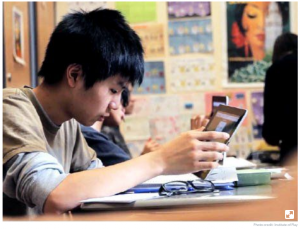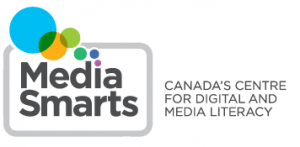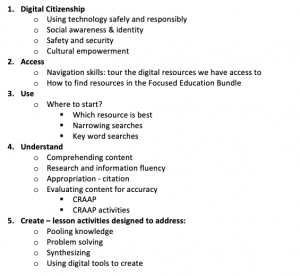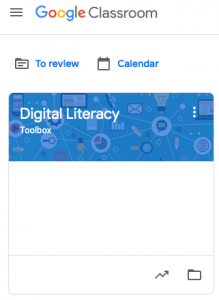
The digital artifact that I am developing for my final vision project is a digital toolbox to support boosting digital literacy skills in a secondary school. This idea came to me as I was preparing digital resource supports for teachers and had received feedback that junior students struggle with locating online references, how to cite, etc. It then prompted me to reflect on how our LLC program teaches digital literacy and I wondered if there was anything that I could develop to target boosting this skill. After some thought, I considered the creation of a toolbox of resources to support students. This evolved into a digital toolbox that would include lessons and interactive activities to help build digital literacy skills.
Audience:
My target audience for the digital tool box is Grade 8. Grade 8s receive a detailed orientation of the library learning commons early in the year. The digital literacy lessons/support material within the toolbox are intended to be used as a mid-year booster. I do see the value in adapting content/skills per year group and this would be a long-term goal if the grade 8 roll-out is successful. Ideally mid-year digital literacy booster skills would benefit each grade level, and the skills being targeted would be tailored to curricular needs of the grade level.
Learner considerations:
In Will Richardson’s book Why School, he explores in the chapter, “Our kids are illiterate,” the National Council of Teachers of English (NCTE) 21st Century Literacies. What stood out to me while supporting teachers by pulling digital resources for their classes, that the NCTE skill to “create, critique, analyze and evaluate multimedia texts” (Richardson, 2012, ch 5) is an area that all students could use more support with improving. Improving students’ digital literacy skills and teaching techniques on evaluating, analyzing and critiquing content will help foster the necessary skills to “participate effectively and critically in a networked world” (NCTE, 2019).
Goal:
The goal of the digital artifact is to provide a teaching toolbox that builds, supports and fosters digital literacy within a library learning commons program.
Format/Delivery:
The digital toolbox will be curated in Google Classroom. I have been reviewing Media Smarts, Digital Literacy Fundamentals, which our school district also uses as an informational tool for digital literacy and am designing my toolbox based on the organizational structure below. My plan is to build a unit that divides lessons and support material into the following categories:

The topics will include material to support. Material will be developed and created but will also include some gathered resources from my research and some district suggested references. Materials will all be digital and created to be shared within the Google Suite platform. These will be in the format of Slides, Docs and Forms which will enable student/staff interactivity. I plan to also create screencasts to demonstrate some of the above skills, especially with navigation through the Focused Education bundle. All materials are designed to be delivered as mini lessons, which can be chunked within longer library sessions or enable targeted roll-outs with classes. The concept is to enable flexibility for classroom teachers. Some teachers may not wish to explore citation, but would like to explore evaluating content for accuracy. By building a digital toolbox with this structure, how little or how much detail teachers wish to explore in a given unit can be designed.
Works cited:
Media Smarts. (n.d). Digital Literacy Fundamentals. Retrieved from https://mediasmarts.ca/digital-media-literacy/general-information/digital-media-literacy-fundamentals/digital-literacy-fundamentals
National Council of Teachers of English. (2019) Position statements. NCTE. Retrieved from https://ncte.org/statement/nctes-definition-literacy-digital-age/
Richardson, W. (2012). Why School?: How Education Must Change When Learning and Information Are Everywhere. TED Conferences. Kindle Edition.


 Follow
Follow
Well done update to your plan, specifically focused on your audience of grade 8 students who need a refresh on their digital literacy skills. Compiling your instruction, lessons, resources and curated tools, all in one google classroom is a great idea as it can easily support all your students across the entire grade. It also will allow you to easily add to, evolve and edit your resources going forward each year to build upon the exisiting skills you are seeing your students. Being adaptable and responsive will help this last a few years and adjust to the changing needs and skill levels. Overall, a solid plan for your school community.